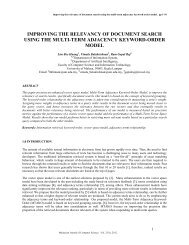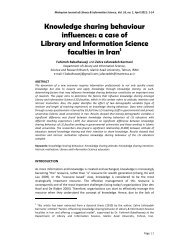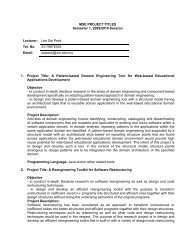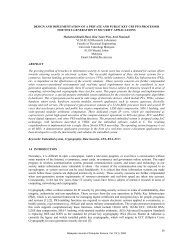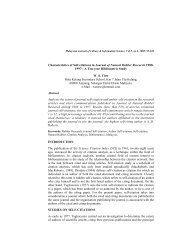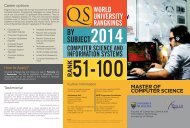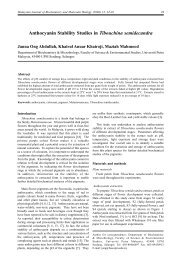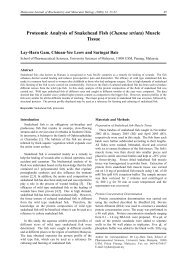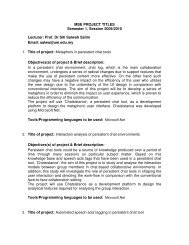Co-authorship network of scientometrics research collaboration - E-LIS
Co-authorship network of scientometrics research collaboration - E-LIS
Co-authorship network of scientometrics research collaboration - E-LIS
- No tags were found...
Create successful ePaper yourself
Turn your PDF publications into a flip-book with our unique Google optimized e-Paper software.
Erfanmanesh, M.; Rohani, V.A. & Abrizah, A.Table 2 also shows the top 20 institutions with the highest betweenness centrality. Thebetweenness centrality scores indicate that University <strong>of</strong> Leuven (0.0797), University <strong>of</strong>Sussex (0.0462) and Hungarian Academy <strong>of</strong> Science (0.0345), Georgia Institute <strong>of</strong>Technology (0.0313), University <strong>of</strong> Amsterdam (0.0287), Katholieke Hogeschool Brugge-Oostende (0.0269), Leiden University (0.0233), University <strong>of</strong> Western Ontario (0.0212),University <strong>of</strong> Granada (0.0202) and Yeungnam University (0.0198) act as key brokers inconnecting various institutions in the <strong>network</strong>. These institutions have the most favouredpositions in the <strong>network</strong> by falling on the geodesic paths between other pairs <strong>of</strong>institutions. Additionally, Hungarian Academy <strong>of</strong> Science (208) is by far the leadinginstitution when the productivity criterion is used. Other most productive institutions are:Leiden University (116), University <strong>of</strong> Leuven (102), National Institute <strong>of</strong> Science,Technology and Development Studies (99), University <strong>of</strong> Antwerp (78), University <strong>of</strong>Amsterdam (62), Institute for Information and Documentation in Science and Technology(57), Spanish National Research <strong>Co</strong>uncil (50), University <strong>of</strong> Sussex (49) and KatholiekeHogeschool Brugge-Oostende (49).The number <strong>of</strong> immediate collaborators, an indicator representing connection and<strong>collaboration</strong> <strong>of</strong> institutions, is 2.16 (SD=3.47) on average, with the maximum value <strong>of</strong> 49for the University <strong>of</strong> Leuven. The second institution with the highest number <strong>of</strong> immediatecollaborator institutions is Hungarian Academy <strong>of</strong> Science (35) followed by KatholiekeHogeschool Brugge-Oostende (31), Spanish National Research <strong>Co</strong>uncil (28), University <strong>of</strong>Granada (25), University <strong>of</strong> Sussex, University <strong>of</strong> Antwerp and Leiden University (24),National Institute <strong>of</strong> Science, Technology and Development Studies (22) and Henan NormalUniversity (21). The results show that the most productive institutions have establishedcollaborative links with a great number <strong>of</strong> institutions. Studying the strength <strong>of</strong><strong>collaboration</strong> between institutions shows that University <strong>of</strong> Leuven and HungarianAcademy <strong>of</strong> Science have the highest number <strong>of</strong> co-authoring links with 160 co<strong>authorship</strong>s.Strong co-<strong>authorship</strong> between institutions is mostly due to a large number <strong>of</strong>co-authored papers between productive individuals in those institutions. Another possibleexplanation for such strong links between institutions is that some authors have publishedtheir papers under different affiliations, which can increase the potential <strong>of</strong> co-authoring <strong>of</strong>those institutions. For example, Glanzel published his papers under the affiliation <strong>of</strong> bothUniversity <strong>of</strong> Leuven and Hungarian Academy <strong>of</strong> Science which can be effective instrengthening co-authoring links between these two institutions. It is noted that thestrongest partnerships in the <strong>network</strong> exist between European universities, while there is aweak co-authoring between North American and European institutions. This finding issomewhat consistent with that <strong>of</strong> Katz (1994) who found that geographical proximityresults in more <strong>collaboration</strong>.It is also worth noting that the centrality, productivity and <strong>collaboration</strong> <strong>of</strong> a university arelargely related to the individuals who are affiliated with that university. In other word,institutional centrality within <strong>collaboration</strong> <strong>network</strong> emerges and develops as authorsaffiliated with that institution create co-authoring links. For example Wolfgang Glanzelplays a vital role in increasing the centrality <strong>of</strong> the University <strong>of</strong> Leuven as well asHungarian Academy <strong>of</strong> Science, just like the role <strong>of</strong> Ronald Rousseau at KatholiekeHogeschool Brugge-Oostende (KHBO), Andras Schubert at Hungarian Academy <strong>of</strong> Science,Mike Thelwall at University <strong>of</strong> Wolverhampton or Martin Meyer at University <strong>of</strong> Sussex.When all <strong>of</strong> the metrics are examined together, it is clear that there are importantinstitutions strategically positioned in the <strong>network</strong> due to their centrality, productivity aswell as <strong>collaboration</strong>. These institutions are University <strong>of</strong> Leuven, Hungarian Academy <strong>of</strong>Science, University <strong>of</strong> Antwerp, KHBO, University <strong>of</strong> Granada, University <strong>of</strong> Amsterdam,Page | 84



